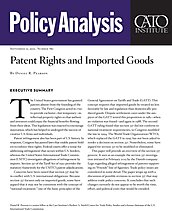Patent infringement also has been part of U.S. history. In response, Congress has passed laws that enable patent holders to enforce their rights. Federal courts offer a venue for addressing infringement that occurs within U.S. borders, whereas the United States International Trade Commission (USITC) investigates allegations of infringement by imports. Section 337 of the Tariff Act of 1930 provides the statutory framework for the USITC’s patent adjudications.
Concerns have been raised that section 337 may be in conflict with U.S. international obligations. Because section 337 focuses only on imported goods, some have argued that it may not be consistent with the concept of “national treatment,” one of the basic principles of the General Agreement on Tariffs and Trade (GATT). This concept requires that imported goods be treated no less favorably by law and regulation than domestically produced goods. Dispute settlement cases under the auspices of the GATT tested this proposition in 1981 — when no violation was found — and again in 1988. The second GATT ruling found that section 337 did not conform to national treatment requirements, so Congress modified the law in 1994. The World Trade Organization (WTO), which replaced the GATT in 1995, has not been asked to render a decision on section 337. Nonetheless, some have argued for section 337 to be modified or eliminated.
This paper will provide an overview of the section 337 process. It uses as an example the section 337 investigation initiated in February 2015 by the Danish company Lego regarding alleged infringement of patents supporting its “Friends” line of figurines. Trade policy issues are considered in some detail. The paper wraps up with a discussion of possible revisions to section 337 that may address trade policy concerns. It concludes that such changes currently do not appear to be worth the time, effort, and political costs that would be entailed.

